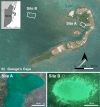Manatees display diel trends in acoustic activity at two microhabitats in Belize
- PMID: 37976271
- PMCID: PMC10655963
- DOI: 10.1371/journal.pone.0294600
Manatees display diel trends in acoustic activity at two microhabitats in Belize
Abstract
Many marine mammals exhibit diel trends in vocal production, which can provide information on habitat use and behavioral activity. In Belize, Antillean manatees (Trichechus manatus manatus) commonly inhabit small depressions in the substrate or deep-water coves known as "resting holes". Determining if manatees exhibit diel temporal trends in their call production rate and call types between microhabitats can provide insights into their diurnal and nocturnal activity patterns. Here, we investigate the diel vocalization patterns of wild Antillean manatees in two adjacent resting holes off of St. George's Caye, Belize. Recordings of manatees were made using a bottom-mounted hydrophone located near a reef barrier reef for nine days in July of 2017 and ten days in January of 2018. To explore if and how manatee acoustic activity differs between sites, we compared the number of calls per hour, the number of manatee positive hours, the number of tonal and atonal sounds, and the number of boats detected across sites. A total of 370 hours of acoustic recordings were analyzed resulting in the detection of 3,262 calls. There were no significant differences in the number of manatee calls produced per hour between sites. The average number of calls produced by manatees decreased over the course of several days. The proportion of tonal calls decreased with hours after sunset and increased in boat presence. These results suggest manatees in this region may exhibit different diel activity patterns which appear to be influenced by the characteristics of the environment. These findings can support ongoing conservation and management efforts to safeguard species in Belize.
Copyright: © 2023 Brady et al. This is an open access article distributed under the terms of the Creative Commons Attribution License, which permits unrestricted use, distribution, and reproduction in any medium, provided the original author and source are credited.
Conflict of interest statement
The authors have declared that no competing interests exist.
Figures







References
-
- Wiggins SM, Oleson EM, McDonald MA, Hildebrand JA. Blue whale (Balaenoptera musculus) diel call patterns offshore of Southern California. Aquat Mamm, 2005;31(2), 161.
-
- Kobayashi N, Okabe H, Higashi N, Miyahara H, Uchida S. Diel patterns in singing activity of humpback whales in a winter breeding area in Okinawan (Ryukyuan) waters. Mar Mamm Sci. 2021; 37(3), 982–992.
MeSH terms
LinkOut - more resources
Full Text Sources
Miscellaneous

